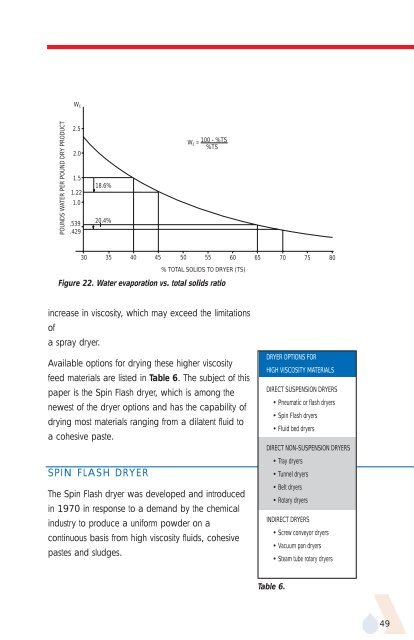APV Dryer Handbook - Umbc
APV Dryer Handbook - Umbc
APV Dryer Handbook - Umbc
Create successful ePaper yourself
Turn your PDF publications into a flip-book with our unique Google optimized e-Paper software.
POUNDS WATER PER POUND DRY PRODUCT<br />
W E<br />
2.5<br />
2.0<br />
1.5<br />
1.22<br />
1.0<br />
.539<br />
.429<br />
18.6%<br />
20.4%<br />
increase in viscosity, which may exceed the limitations<br />
of<br />
a spray dryer.<br />
Available options for drying these higher viscosity<br />
feed materials are listed in Table 6. The subject of this<br />
paper is the Spin Flash dryer, which is among the<br />
newest of the dryer options and has the capability of<br />
drying most materials ranging from a dilatent fluid to<br />
a cohesive paste.<br />
SPIN FLASH DRYER<br />
WE = 100 - %TS<br />
%TS<br />
30 35 40 45 50 55 60 65 70 75 80<br />
% TOTAL SOLIDS TO DRYER (TS)<br />
Figure 22. Water evaporation vs. total solids ratio<br />
The Spin Flash dryer was developed and introduced<br />
in 1970 in response to a demand by the chemical<br />
industry to produce a uniform powder on a<br />
continuous basis from high viscosity fluids, cohesive<br />
pastes and sludges.<br />
DRYER OPTIONS FOR<br />
HIGH VISCOSITY MATERIALS<br />
DIRECT SUSPENSION DRYERS<br />
• Pneumatic or flash dryers<br />
• Spin Flash dryers<br />
• Fluid bed dryers<br />
DIRECT NON-SUSPENSION DRYERS<br />
• Tray dryers<br />
• Tunnel dryers<br />
• Belt dryers<br />
• Rotary dryers<br />
INDIRECT DRYERS<br />
• Screw conveyor dryers<br />
• Vacuum pan dryers<br />
• Steam tube rotary dryers<br />
Table 6.<br />
49











